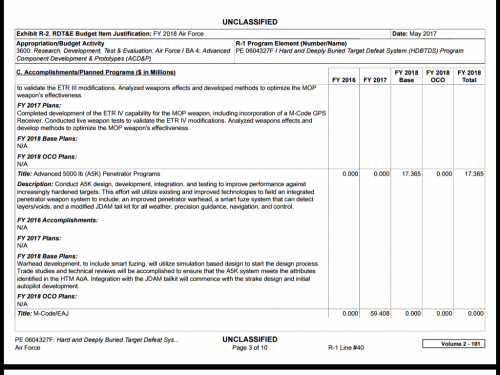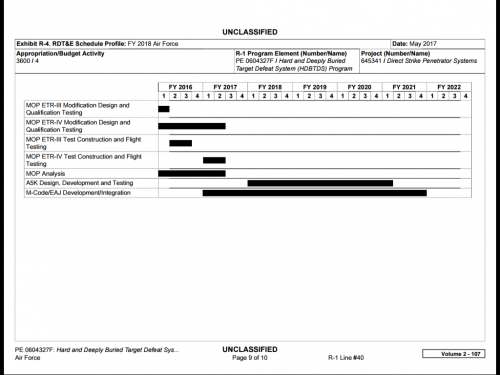- Joined
- 21 April 2009
- Messages
- 13,551
- Reaction score
- 7,153
Air Force To Outbrief AFROC, JROC On Hard Target Munitions Analysis
Posted: April 02, 2015
The Air Force could soon start building a next-generation family of bunker-killing weapons to include the Air Force Research Laboratory's 2,000-pound High Velocity Penetrating Weapon for the F-35 Joint Strike Fighter, following the internal release of the service's classified hard-target munitions analysis of alternatives.
Air Combat Command is due to outbrief the report to senior leaders on the Air Force Requirements Oversight Council in June before taking its recommendations to the higher Joint Requirements Oversight Council in the mid-summer time frame.
A spokesman for ACC provided the planned briefing dates in a March 31 email to Inside the Air Force.
Asked whether some of the recommendations are funded in the service's fiscal year 2016 budget request, the spokesman, Benjamin Newell, said the recommendations are classified, as are some of the actions taken.
He said the Air Force is still developing its FY-17 spending proposal, and he would not speculate as to whether funding for new penetrating munitions would be included in the service's next program objective memorandum.
"Air Combat Command is charged with performing evaluations like this because we're in direct contact with combatant commanders and are in tune with their needs," Newell said. "Our mission is to organize, train and equip America's combat air forces for today's fight while planning and equipping for tomorrow's operations."
The AOA was conducted through FY-14 and was recently completed.
According to Air Force officials, one of the weapons considered was the Air Force's largest conventional bunker bomb, the 30,000-pound GBU-57 Massive Ordnance Penetrator, but the study is likely to recommend producing a family of weapons with different bombs and capabilities for different target sets within the hard-and-deeply-buried-targets mission area. That includes lighter weapons for carriage on tactical and stealthy fighter jets as well as modifications to existing penetrators. The Air Force also has a nuclear earth-penetrating weapon in its inventory, the B61-11.
The clearest indication of what type of weapon might come out of the study was provided at a March 26 House Armed Services Committee hearing by David Walker, the Air Force's deputy assistant secretary for science, technology and engineering.
He told the committee that the scientific community was working with ACC to come up with new solutions to attack hard and deeply buried targets with existing capabilities on existing platforms as well as new technologies.
"We need to have smaller, more compact systems," Walker said. "So the High Velocity Penetrating Weapon (HVPW) was a program that we put together to do this. [It has] been very successful and now it's transitioned that technology into the follow-on program that ACC is now looking at in their AOA."
The weapon he was referencing is a 2011 program initiated by the Air Force Research Laboratory to create a bunker bomb for internal carriage on the F-35 and well as legacy fighters and bombers.
According to media reports, HVPW is a rocket-boosted, bunker-buster munition developed by AFRL with industry partners Lockheed Martin and Raytheon through a program called the High Velocity Penetrating Weapon Flagship Capability Concept. An AFRL slide presentation from 2011 states that sled testing would occur in 2012 and the technology would be ready to transition to a development program in 2014.
The 2,000-pound weapon would have an "innovative fuze design" and the rocket motor would accelerate the weapon and drive it deep underground like a pile driver.
The study might have also informed the decision to install new modifications on the Massive Ordnance Penetrator, a heavy weapon initially produced to satisfy an urgent operational need. MOP is integrated with the B-2 Spirit bomber and has been dropped from a B-52 Stratofortress.
In a March 26 interview with ITAF, Air Force Program Executive Officer for Weapons Maj. Gen Scott Jansson said the MOP was considered in the AOA but would probably never be produced in great quantities since very few aircraft can carry it.
"We're looking at less-expensive weapons than MOP that we can build in greater quantities, but MOP was considered in that AOA as well," Jansson said. "[It] might be part of a family of capabilities that can hold certain targets at risk."
The Air Force's FY-16 budget request that was submitted to Congress on Feb. 2 includes additional funding for two sets of MOP modifications known as Enhanced Threat Reduction Phased III and IV. Flight testing for those modifications is due to start later this year and would continue through 2017. -- James Drew
-----------------------------------------------------------
Classified report unfortunately.
Posted: April 02, 2015
The Air Force could soon start building a next-generation family of bunker-killing weapons to include the Air Force Research Laboratory's 2,000-pound High Velocity Penetrating Weapon for the F-35 Joint Strike Fighter, following the internal release of the service's classified hard-target munitions analysis of alternatives.
Air Combat Command is due to outbrief the report to senior leaders on the Air Force Requirements Oversight Council in June before taking its recommendations to the higher Joint Requirements Oversight Council in the mid-summer time frame.
A spokesman for ACC provided the planned briefing dates in a March 31 email to Inside the Air Force.
Asked whether some of the recommendations are funded in the service's fiscal year 2016 budget request, the spokesman, Benjamin Newell, said the recommendations are classified, as are some of the actions taken.
He said the Air Force is still developing its FY-17 spending proposal, and he would not speculate as to whether funding for new penetrating munitions would be included in the service's next program objective memorandum.
"Air Combat Command is charged with performing evaluations like this because we're in direct contact with combatant commanders and are in tune with their needs," Newell said. "Our mission is to organize, train and equip America's combat air forces for today's fight while planning and equipping for tomorrow's operations."
The AOA was conducted through FY-14 and was recently completed.
According to Air Force officials, one of the weapons considered was the Air Force's largest conventional bunker bomb, the 30,000-pound GBU-57 Massive Ordnance Penetrator, but the study is likely to recommend producing a family of weapons with different bombs and capabilities for different target sets within the hard-and-deeply-buried-targets mission area. That includes lighter weapons for carriage on tactical and stealthy fighter jets as well as modifications to existing penetrators. The Air Force also has a nuclear earth-penetrating weapon in its inventory, the B61-11.
The clearest indication of what type of weapon might come out of the study was provided at a March 26 House Armed Services Committee hearing by David Walker, the Air Force's deputy assistant secretary for science, technology and engineering.
He told the committee that the scientific community was working with ACC to come up with new solutions to attack hard and deeply buried targets with existing capabilities on existing platforms as well as new technologies.
"We need to have smaller, more compact systems," Walker said. "So the High Velocity Penetrating Weapon (HVPW) was a program that we put together to do this. [It has] been very successful and now it's transitioned that technology into the follow-on program that ACC is now looking at in their AOA."
The weapon he was referencing is a 2011 program initiated by the Air Force Research Laboratory to create a bunker bomb for internal carriage on the F-35 and well as legacy fighters and bombers.
According to media reports, HVPW is a rocket-boosted, bunker-buster munition developed by AFRL with industry partners Lockheed Martin and Raytheon through a program called the High Velocity Penetrating Weapon Flagship Capability Concept. An AFRL slide presentation from 2011 states that sled testing would occur in 2012 and the technology would be ready to transition to a development program in 2014.
The 2,000-pound weapon would have an "innovative fuze design" and the rocket motor would accelerate the weapon and drive it deep underground like a pile driver.
The study might have also informed the decision to install new modifications on the Massive Ordnance Penetrator, a heavy weapon initially produced to satisfy an urgent operational need. MOP is integrated with the B-2 Spirit bomber and has been dropped from a B-52 Stratofortress.
In a March 26 interview with ITAF, Air Force Program Executive Officer for Weapons Maj. Gen Scott Jansson said the MOP was considered in the AOA but would probably never be produced in great quantities since very few aircraft can carry it.
"We're looking at less-expensive weapons than MOP that we can build in greater quantities, but MOP was considered in that AOA as well," Jansson said. "[It] might be part of a family of capabilities that can hold certain targets at risk."
The Air Force's FY-16 budget request that was submitted to Congress on Feb. 2 includes additional funding for two sets of MOP modifications known as Enhanced Threat Reduction Phased III and IV. Flight testing for those modifications is due to start later this year and would continue through 2017. -- James Drew
-----------------------------------------------------------
Classified report unfortunately.



